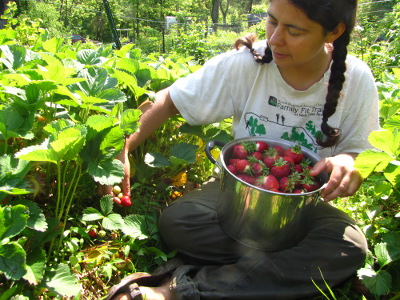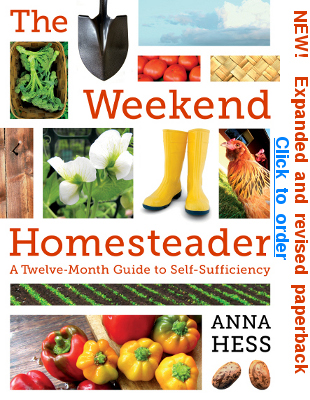
Easy berries
 In the long run, an orchard
provides the most fruit per hour of
maintenance, but berries fill in the gap while you're waiting for
your apple trees to produce. Luckily, easy berry plants like
strawberries and raspberries will start producing in a year or
less. Better yet, they're so easy to propagate that you'll soon
have filled up every nook and cranny of your yard with edibles and will
be begging neighbors to take extra plants off your hands.
In the long run, an orchard
provides the most fruit per hour of
maintenance, but berries fill in the gap while you're waiting for
your apple trees to produce. Luckily, easy berry plants like
strawberries and raspberries will start producing in a year or
less. Better yet, they're so easy to propagate that you'll soon
have filled up every nook and cranny of your yard with edibles and will
be begging neighbors to take extra plants off your hands.
Choosing your berries
The
primary purpose of this week's exercise is to be harvesting your own
fruit in
a year or less. As a result, I'm going to focus on the quickest
bearing berries --- blackberries, raspberries, and strawberries.
Each of these plants require only minimal to moderate care, with their
differences detailed in the chart below.
| USDA
hardiness zones |
pH |
Spacing (feet) |
Notes |
|
| Blackberry |
5-10 |
5.5-7.0 |
3-10 |
Best in southern climates and
for people with lots of space |
| Raspberry, red |
3-8 |
6.0-6.8 |
1-2 |
Best in northern climates; can
fit into smaller spaces than other brambles |
| Raspberry, black |
5-8 |
6.0-6.8 | 2-3 |
A good southern berry for those
with less space, but not as productive as other brambles |
| Strawberry |
3-8 |
6.5-6.8 |
1-2 |
You can tuck a few strawberry
plants into even the smallest garden, but they take more care than the
brambles |
If you're feeling patient, you might want to select additional small fruits from the second chart below. Although you may get a grape or blueberry the first or second year, these "advanced" species all require four or five years to reach their full potential. I consider a blueberry patch a long term investment --- on par with planting a fruit tree --- while strawberries and raspberries can be snuck into the yard of a rental property.
| USDA
hardiness zones |
pH |
Spacing (feet) |
Notes |
|
| Blueberry, highbush |
3-8 |
4.5-5.5 |
6-8 |
Best in northern climates; must
have acidic soil; needs more than one variety for pollination |
| Blueberry,
rabbiteye |
7-9 | 4.5-5.5 |
6-8 |
Best in southern climates; must
have acidic soil; needs more than one variety for pollination |
| Currant |
3-6 |
6.2-6.5 |
4 |
Best in northern climates; some
states don't allow you to plant certain varieties because of the white
pine blister rust |
| Gooseberry |
3-7 |
6.2-6.5 |
4 |
Best in northern climates but
can be planted a bit further south than currants; if you live in the
south, try to find a cool microclimate |
| Grape |
3-8 |
6.0-7.5 |
8-10 |
Bunch grapes hate hot, humid
summers, so consider muscadines in the deep south |
| Kiwi |
5-8 |
5.0-6.5 |
10 |
Kiwis come in male and female
varieties --- be sure to plant at least one male for every eight
females; only hardy
kiwis can survive below zone 7 |
 For the rest of this
lunchtime series, I'll be focusing on care of the
simplest berry varieties. If you decide to plant any of the more
"advanced" small fruits from the second chart, you'll need to do a bit
of extra research on pruning and trellising. But don't let that
discourage you --- all of these small fruits are well within the reach
of the backyard homesteader.
For the rest of this
lunchtime series, I'll be focusing on care of the
simplest berry varieties. If you decide to plant any of the more
"advanced" small fruits from the second chart, you'll need to do a bit
of extra research on pruning and trellising. But don't let that
discourage you --- all of these small fruits are well within the reach
of the backyard homesteader.This week's lunchtime series is exerpted from Weekend Homesteader: February, which is available for 99 cents from Amazon's kindle store. The ebook also includes a primer on choosing and caring for a backyard flock of chickens, information on buying in bulk, and tips for creating your own apprenticeship. If you enjoy the book, please consider leaving me a review.
| This post is part of our Easy Berries lunchtime series.
Read all of the entries: |
Want more in-depth information? Browse through our books.
Or explore more posts by date or by subject.
About us: Anna Hess and Mark Hamilton spent over a decade living self-sufficiently in the mountains of Virginia before moving north to start over from scratch in the foothills of Ohio. They've experimented with permaculture, no-till gardening, trailersteading, home-based microbusinesses and much more, writing about their adventures in both blogs and books.
Want to be notified when new comments are posted on this page? Click on the RSS button after you add a comment to subscribe to the comment feed, or simply check the box beside "email replies to me" while writing your comment.

How do you keep your chickens out of the berries? I have begun reading your Feb e-book, do you discuss that at all? Are there any benefits to a raised bed for strawberries?
Thanks!
I cover that more in the chicken section of the January ebook than in the berries section. Chickens wreak havoc in the garden, so I don't let them in! Our chickens get to free range in the winter if they're well-behaved, but in the summer they've always been in pastures or tractors.
Raised beds have a lot of pros and cons in general, so you have to decide whether they make sense for your garden. They're great for us because we have clayey soil that tends to get waterlogged, but my father has sandy soil and is in a hotter climate, so they would be a very bad idea for him. On the other hand, I recommend permanent beds to everyone since your growing area soil won't get compressed if you have designated aisles, and you can use less soil amendments to get more results if you don't have to treat the aisles.